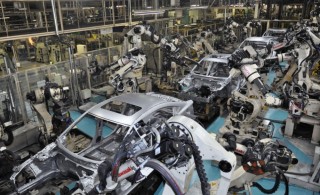Loading
Search
▼ Japan’s April-June GDP Upgraded to Annualized 3.0% Growth
- Category:Event
The economy grew at an annual rate of 3.0 percent in the April-June quarter, the fastest pace in more than two years and much faster than initially reported thanks to an upswing in capital expenditure, the government said Monday.
The upward revision from a 1.9 percent expansion confirmed the world’s third-largest economy had rebounded from a temporary slowdown in the previous quarter following two years of continuous expansion, which had been the longest stretch of uninterrupted growth in 28 years.
The growth rate was the fastest since the January-March quarter of 2016 and beat the average 2.7 percent growth forecast by polled private-sector economists.
The growth in real gross domestic product — the total value of goods and services produced in the country adjusted for inflation — corresponds to a 0.7 percent increase from the previous quarter, revised up from the Cabinet Office’s preliminary reading of a 0.5 percent rise.
Companies have been stepping up investment in factories and equipment after enjoying record earnings in recent years, as they rush to meet robust demand from overseas, and in connection with a construction boom at home ahead of the 2020 Tokyo Olympics.
“We expect this trend to continue through mid-fiscal 2019, with the economy then reaching a turning point … triggered by the consumption tax hike planned for October 2019,” said Tetsufumi Yamakawa, an economist at Barclays Securities Japan.
Having just come out of an annualized 0.9 percent contraction in January-March, Yamakawa said the economy could slow again in July-September due to the impact of a typhoon in western Japan and a strong earthquake in Hokkaido.
“The trade dispute between the United States and China is also a risk, as it could affect not only demand for exports but also currency rates,” he added.
Quarter-on-quarter growth in capital expenditure was upgraded to 3.1 percent from 1.3 percent, pushed up by a wide range of industries including electronics-makers and chemical firms.
Private consumption, which accounts for more than half of GDP, was unchanged at a 0.7 percent increase.
Prime Minister Shinzo Abe has called on companies to stop hoarding cash and raise wages in order to boost household spending. The Bank of Japan hopes stronger consumption will give businesses the confidence to raise the prices of goods and services and lift stubbornly stagnant inflation toward its 2 percent target.
Residential investment declined less than previously thought, contracting 2.4 percent rather than 2.7 percent. Public investment was slightly upgraded to 0.02 percent growth from a 0.1 percent decrease.
Exports, an important driver of Japan’s economy in past quarters, were unchanged at 0.2 percent growth. Growth in imports, which is subtracted from GDP, was slightly downgraded to 0.9 percent from 1.0 percent.
Nominal GDP, which is not adjusted for inflation, grew an annualized 2.8 percent, up from a 1.7 percent expansion.
The upward revision from a 1.9 percent expansion confirmed the world’s third-largest economy had rebounded from a temporary slowdown in the previous quarter following two years of continuous expansion, which had been the longest stretch of uninterrupted growth in 28 years.
The growth rate was the fastest since the January-March quarter of 2016 and beat the average 2.7 percent growth forecast by polled private-sector economists.
The growth in real gross domestic product — the total value of goods and services produced in the country adjusted for inflation — corresponds to a 0.7 percent increase from the previous quarter, revised up from the Cabinet Office’s preliminary reading of a 0.5 percent rise.
Companies have been stepping up investment in factories and equipment after enjoying record earnings in recent years, as they rush to meet robust demand from overseas, and in connection with a construction boom at home ahead of the 2020 Tokyo Olympics.
“We expect this trend to continue through mid-fiscal 2019, with the economy then reaching a turning point … triggered by the consumption tax hike planned for October 2019,” said Tetsufumi Yamakawa, an economist at Barclays Securities Japan.
Having just come out of an annualized 0.9 percent contraction in January-March, Yamakawa said the economy could slow again in July-September due to the impact of a typhoon in western Japan and a strong earthquake in Hokkaido.
“The trade dispute between the United States and China is also a risk, as it could affect not only demand for exports but also currency rates,” he added.
Quarter-on-quarter growth in capital expenditure was upgraded to 3.1 percent from 1.3 percent, pushed up by a wide range of industries including electronics-makers and chemical firms.
Private consumption, which accounts for more than half of GDP, was unchanged at a 0.7 percent increase.
Prime Minister Shinzo Abe has called on companies to stop hoarding cash and raise wages in order to boost household spending. The Bank of Japan hopes stronger consumption will give businesses the confidence to raise the prices of goods and services and lift stubbornly stagnant inflation toward its 2 percent target.
Residential investment declined less than previously thought, contracting 2.4 percent rather than 2.7 percent. Public investment was slightly upgraded to 0.02 percent growth from a 0.1 percent decrease.
Exports, an important driver of Japan’s economy in past quarters, were unchanged at 0.2 percent growth. Growth in imports, which is subtracted from GDP, was slightly downgraded to 0.9 percent from 1.0 percent.
Nominal GDP, which is not adjusted for inflation, grew an annualized 2.8 percent, up from a 1.7 percent expansion.
- September 11, 2018
- Comment (0)
- Trackback(0)


